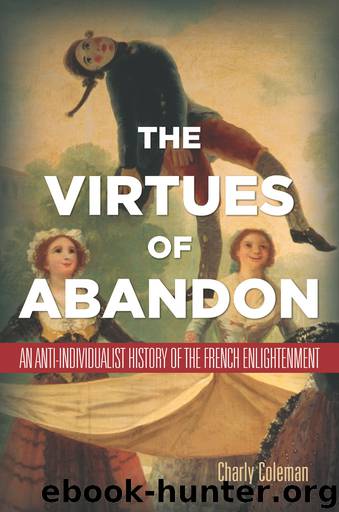The Virtues of Abandon by Coleman Charly

Author:Coleman, Charly [Coleman, Charly]
Language: eng
Format: epub
Publisher: Stanford University Press
Published: 2014-04-14T16:00:00+00:00
7
Revolutionary Reveries
In the wake of Robespierre’s ouster in the coup of 9 thermidor Year II of the French Revolution (July 27–28, 1794), the long-held plans to rebury Rousseau in the Pantheon at last came to fruition. A resurrection more than a funeral, the proceedings spanned three days, from 18 to 20 vendémaire Year III (October 9–11, 1794). For the final ceremony, soldiers, artists, musicians, a deputation from the Paris sections, mothers with babes in arms, dignitaries from Ermenonville and Geneva, and members of the Institute of Music assembled ahead of deputies from the National Convention. The representatives marched with “the beacon of legislators,” a copy of Rousseau’s Du Contrat social, guiding their way. Upon reaching the Pantheon, the participants listened to hymns chosen for the occasion.1 In the words of one librettist, Théodore Desorgues, the scene provoked not only a rush of gratitude but also a palpable desire for communion. “Come out of your funeral urn,” the musicians sang, and “see this liberated people, who implore you as their father.” According to the lyric, Rousseau’s ashes, like a burnt offering, function as a conduit between the celestial and temporal spheres. Addressing the Citizen of Geneva, Desorgues expectantly awaited the moment “when your soul is reunited in the bosom of the universal being.” “Let us offer it new honors,” the poet implored the assembly, “and by our unanimous consent, consecrate his sublime remains.”2
Rousseau’s pantheonization had been delayed for years due to the chronic instability faced by the nascent Republic. The political leadership in France sought to regenerate the body politic from within, while facing the dual existential threat of war and civil war. This transformative enterprise led to intense speculation about the nature of citizenship—and therefore about the kind of self that the new regime should engender. In light of the polemics over personhood examined in this book, it can reasonably be asserted that the French Revolution marked the eighteenth century’s last and most explosive clash between the cultures of self-ownership and dispossession. On the one hand, successive revolutionary governments enshrined the rights-bearing citizen in the legal framework its members designed and strove to implement. On the other hand, there was a simultaneous drive to eschew political individualism in favor of an ideal of civic virtue privileging the collective needs of the patrie. The tensions between autonomy and abandon explored in Rousseau’s writings struck a chord with the revolutionaries, who found their own preoccupations reflected in this work.
To be sure, ever since Louis-Sébastien Mercier pronounced him the “first author of the Revolution,” Rousseau’s relationship with the events of 1789 has been contested. Some commentators, most notably Roger Chartier, have even inverted the genealogy. On this latter view, Rousseau’s intellectual and political stature, and the prestige of the philosophes more generally, becomes la faute de la Révolution, with their writings serving to invent origins for, and thereby legitimate, the new regime.3 Rousseau abandoned five children to foundling hospitals, and it would seem that, in death as in life, he remained adept at evading paternal responsibility.
Download
This site does not store any files on its server. We only index and link to content provided by other sites. Please contact the content providers to delete copyright contents if any and email us, we'll remove relevant links or contents immediately.
| Africa | Americas |
| Arctic & Antarctica | Asia |
| Australia & Oceania | Europe |
| Middle East | Russia |
| United States | World |
| Ancient Civilizations | Military |
| Historical Study & Educational Resources |
Cecilia; Or, Memoirs of an Heiress — Volume 1 by Fanny Burney(32080)
Cecilia; Or, Memoirs of an Heiress — Volume 3 by Fanny Burney(31471)
Cecilia; Or, Memoirs of an Heiress — Volume 2 by Fanny Burney(31422)
The Secret History by Donna Tartt(18232)
Sapiens: A Brief History of Humankind by Yuval Noah Harari(13999)
Leonardo da Vinci by Walter Isaacson(12818)
The Radium Girls by Kate Moore(11641)
Sapiens by Yuval Noah Harari(5131)
How Democracies Die by Steven Levitsky & Daniel Ziblatt(4972)
The Wind in My Hair by Masih Alinejad(4852)
Homo Deus: A Brief History of Tomorrow by Yuval Noah Harari(4695)
Endurance: Shackleton's Incredible Voyage by Alfred Lansing(4518)
Man's Search for Meaning by Viktor Frankl(4300)
The Silk Roads by Peter Frankopan(4277)
Millionaire: The Philanderer, Gambler, and Duelist Who Invented Modern Finance by Janet Gleeson(4117)
The Rape of Nanking by Iris Chang(4027)
Hitler in Los Angeles by Steven J. Ross(3803)
Joan of Arc by Mary Gordon(3797)
The Motorcycle Diaries by Ernesto Che Guevara(3796)
